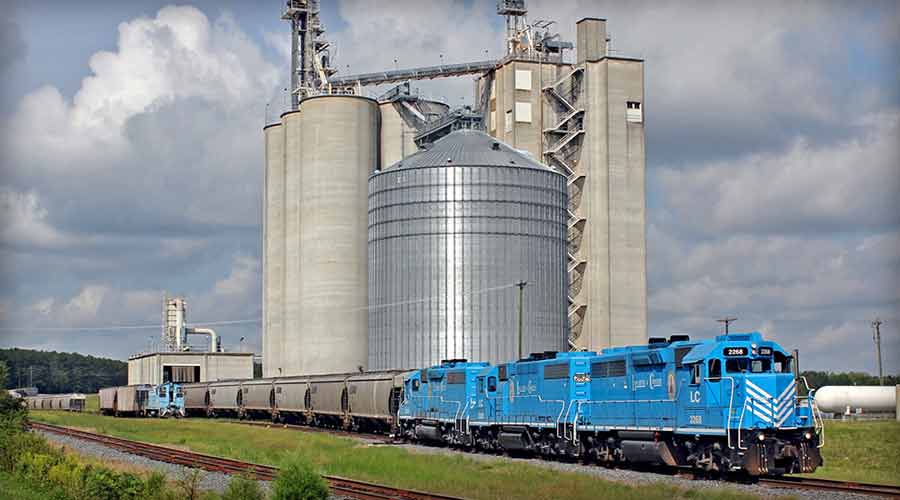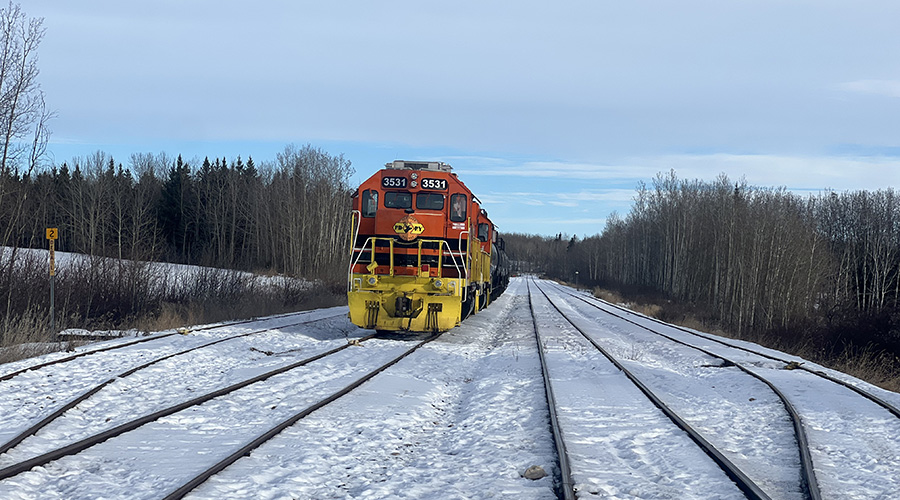Short-line traffic: More downs than ups in year's first half
8/11/2023
By Jeff Stagl, Managing Editor
Many regionals and short lines continued to deal with declining traffic in 2023’s first half.
Collectively, 481 small railroads logged 3,340,404 carloads in the period, down 4.3% compared with first-half 2022’s mark, according to the RailConnect Index of Short Line Traffic compiled by Wabtec Corp.’s GE Transportation arm. The index data covers a 26-week period that ended July 1.
Among 14 commodity groups, the biggest decliners were coal and paper products, which plummeted 24.4% to 160,657 units and 20.5% to 163,061 units, respectively.
In addition, intermodal loads fell 8.6% to 577,537 units; lumber and forest products volume dropped 4.9% to 148,782 units; grain carloads declined 4.7% to 380,067 units; ores traffic dipped nearly 3% to 77,838 units; and chemicals volume decreased 1.8% to 625,418 units.
The railroads notched gains in only four commodity groups, led by a 25.4% jump in all other carloads to 54,393 units and 21.9% leap in motor vehicles and equipment volume to 95,424 units. Farm and food products (excluding grain) volume rose 3% to 164,317 units, while metals and products traffic bumped up 1.6% to 239,277 units.
RailPrime recently conducted an informal poll of regional and short-line officials to learn how their traffic fared in the first half and what drove or hindered it. Emailed comments from nine respondents follow.
Five on the downswing
Watco’s total volume dipped 0.6% year over year to 388,768 carloads. The company — which owns and operates more than 40 regionals and short lines — cites grain as an impediment in the period.
A poor wheat harvest in the Central Plains — such as in Kansas — had the biggest negative impact on first-half traffic, said Jimmy Patterson, Watco’s senior vice president of operations and sales.
 Kansas & Oklahoma Railroad’s grain carloads trailed 2022 comparisons in both May and June. The 974-mile regional is owned and operated by Watco. Watco
Kansas & Oklahoma Railroad’s grain carloads trailed 2022 comparisons in both May and June. The 974-mile regional is owned and operated by Watco. Watco “We have seen one of the worst wheat crops in many years. It is estimated by the Kansas Grain Commission that 18% of planted fields were abandoned due to poor crops,” he said.
In May and June, the Kansas & Oklahoma Railroad trailed 2022 comparisons by 2,200 and 2,400 carloads, respectively.
“Fortunately, strong aggregate carloads on the South Kansas & Oklahoma Railroad and the Kanawha River Railroad helped us make up some of that loss,” Patterson said.
Softer grain demand also hampered CRANDIC Rail’s first-half traffic, which was down on a year-over-year basis. Owned by logistics services provider Travero, the short line operates 100 miles of track in east-central Iowa and directly interchanges or connects with all the Class Is, Iowa Interstate Railroad Ltd. and Iowa Northern Railway Co.
“Grain is the main culprit, although that is a function of where the carryover from last year was ‘truck versus rail friendly’ areas versus economic factors, per se,” said Jeff Woods, Travero’s director of business development.
Likewise, weaker grain business was too much to overcome for the Red River Valley & Western Railroad Co. (RRVW), which operates more than 500 miles of track primarily in southeast North Dakota and interchanges with BNSF Railway Co. and Canadian Pacific Kansas City (CPKC). The regional’s first-half traffic fell 9%.
 Grain was a pain for the Red River Valley & Western Railroad Co. in the first half. Weak grain demand was the primary reason the regional’s traffic fell 9%. Red River Valley & Western Railroad Co.
Grain was a pain for the Red River Valley & Western Railroad Co. in the first half. Weak grain demand was the primary reason the regional’s traffic fell 9%. Red River Valley & Western Railroad Co. “The grain shuttle business has underperformed versus last year due to soft export demand for agricultural products,” said RRVW President Victor Meyers.
However, higher single grain carloads moving to domestic markets and a strong local grain program — through which the railroad handles both the origination and destination — helped partially offset the lower shuttle volume, he said.
“Outside of soft export demand decreasing the shuttle originations, the remainder of our business is on plan year to date,” Meyers said.
For Buckingham Branch Railroad (BBR), there are a number of reasons why its traffic tumbled 5.7% in the first half. The main one is the short line completed a large one-time shipment of pipe in first-quarter 2022, which distorts the year-over-year comparison.
“If we exclude that one-time move, our traffic is pretty flat,” said BBR President Steve Powell.
The short line — which operates 280 miles of track in Virginia and interchanges with CSX, Norfolk Southern Railway and the Durbin and Greenbrier Valley Railroad — has experienced some big swings in traffic so far this year.
For example, outbound woodchip loads are down 35% due to decreased demand for finished products from a paper mill and inbound cement loads are down 42% due to a plant’s production issues, but local aggregate moves are up 46% due to increased local demand, said Powell.
“On a side note, overhead empties (coal and grain) continue to be strong,” he added.
First-half traffic also was fairly weak for the New Orleans Public Belt Railroad (NOBP), the nation’s fifth-largest rail gateway. The short line operates 26 miles of mainline track and 75 miles of total track, and interchanges with all the Class Is.
Owned by the Port of New Orleans, NOPB registered 83,679 units, down 8% compared with first-half 2022’s 91,411 units. The short line didn’t provide traffic details for the period.
Four on the rise
Conversely, first-half traffic was surprisingly robust for Gulf & Ohio Railways Inc., which owns and operates five short lines in the East. Collectively, carloads were up 8.3%, said Peter “Doc” Claussen Jr., the company’s VP.
“The drivers were an unexpected return of a road salt move at the Knoxville & Holston River Railroad, two new customers for the Lancaster & Chester Railroad and a restart of a transloading facility on the Yadkin Valley Railroad,” he said.
In the Southeast, Mississippi Export Railroad (MSE) overcame a coal traffic decline to boost total volume on a year-over-year basis. The 42-mile short line operates between Evanston and Pascagoula, Mississippi, and interchanges with CN, CSX, CPKC and NS.
“Wood products were up meaningfully (due to a new wood pellet plant coming online), plus aggregates and metals were also up,” said MSE President and CEO Kate Luce Bourgeois.
 The 42-mile Mississippi Export Railroad overcame weak coal traffic to boost overall carloads in the first half. Mississippi Export Railroad
The 42-mile Mississippi Export Railroad overcame weak coal traffic to boost overall carloads in the first half. Mississippi Export Railroad Although carloads rose overall, “we miss that coal,” she added.
Ironhorse Resources Ltd. had a strong first half, as well. Volume among its eight short lines — many of which operate in Texas — was 10% higher than what the company had budgeted through June, said Greg Wheeler, Ironhorse Resources’ vice president of operations and safety.
“Frac sand has been the major driver in south Texas,” he said.
Meanwhile, it’s been an extraordinarily busy year for Sierra Northern Railway, which operates 75 miles of track and several branch lines in northern California, and interchanges with BNSF and Union Pacific Railroad. Landing a lot of new business has paid off.
“We are certainly bucking the national trends. We are up across the board with nearly all commodities, showing a year-to-date growth of over 63%,” said Sierra Northern CEO Kennan Beard.
The short line expects its traffic to continue mounting for the remainder of the year.
“Our customers are all showing a strong rail shipping year,” said Beard.


